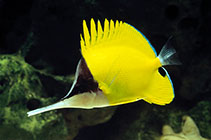| Family: |
Chaetodontidae (Butterflyfishes) |
| Max. size: |
22 cm TL (male/unsexed) |
| Environment: |
reef-associated; marine; depth range 0 - 200 m, non-migratory |
| Distribution: |
Indo-Pacific: East Africa to the Hawaiian, Marquesan, and Pitcairn islands, north to the Bonin [=Ogasawara] Islands, south to New Caledonia and the Austral Islands; throughout Micronesia. |
| Diagnosis: |
Dorsal spines (total): 10-11; Dorsal soft rays (total): 24-28; Anal spines: 3-3; Anal soft rays: 17-20. Description: Head dorsal black and ventral white silver, body yellow; median fins yellow, anal fin spot black bellow tail base (Ref. 90102). Rare uniformly black color phase (Ref. 4855). Snout extremely long (Ref. 48636). Snout length 1.4-1.7 in HL. Body depth 2.1-2.5 in SL (Ref. 90102). . |
| Biology: |
A generally uncommon species that inhabits seaward reefs to depths greater than 60 m (Ref. 9710). Benthopelagic (Ref. 58302). Feeds mainly on whole organisms such as small crustaceans. Usually seen in pairs. Oviparous (Ref. 205), monogamous (Ref. 52884). Forms pairs during breeding (Ref. 205). Sometimes dark brown instead of yellow (Ref. 48636). In the East Indian region this species is replaced by F. wanai at Cenderawasih Bay (Ref. 90102). Minimum depth reported taken from Ref. 128797. |
| IUCN Red List Status: |
Least Concern (LC); Date assessed: 09 October 2009 Ref. (130435)
|
| Threat to humans: |
harmless |
Source and more info: www.fishbase.org. For personal, classroom, and other internal use only. Not for publication.

